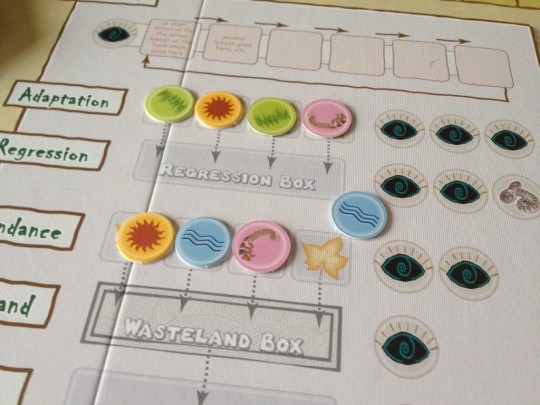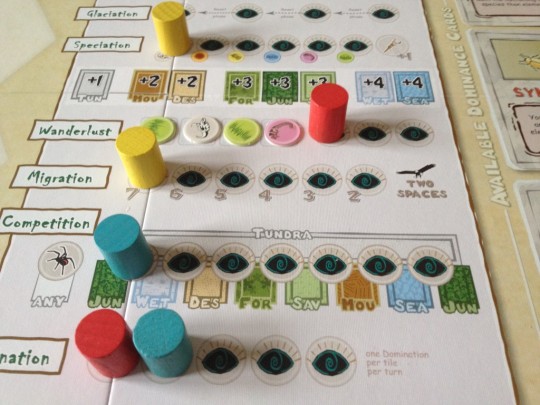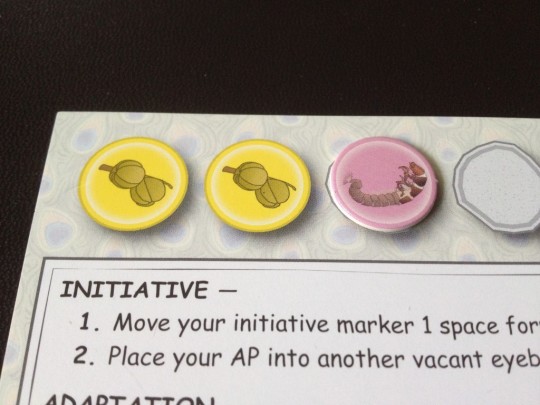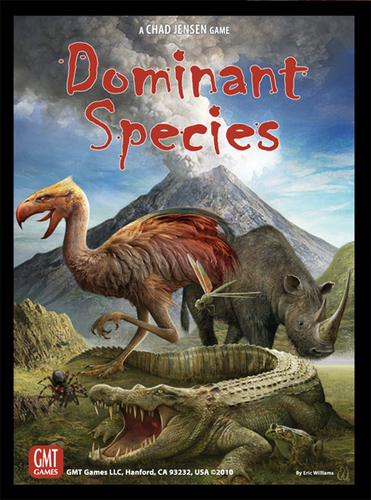Dominant Species is an area control, worker placement game.
Title: Dominant Species
Year Published: 2010
Designer: Chad Jensen
Publisher: GMT Games
Players: 2-6
Game Time: ~240 Mins
Set-up Time: >10 Mins
Ages: 14+
Theme: Prehistoric
Mechanic: Worker Placement, Area Control.
How to win: Get the most Victory Points by controlling areas before the Ice Age arrives..
Game Description
90,000 B.C. — A great ice age is fast approaching. Another titanic struggle for global supremacy has unwittingly commenced between the varying animal species.
Dominant Species is a game that abstractly recreates a tiny portion of ancient history: the ponderous encroachment of an ice age and what that entails for the living creatures trying to adapt to the slowly-changing earth.Each player will assume the role of one of six major animal classes—mammal, reptile, bird, amphibian, arachnid, or insect. Each begins the game more or less in a state of natural balance in relation to one another. But that won’t last: It is indeed “survival of the fittest”.
Dominant Species Set Up

Give each player an Animal and add the Initiative token to the track in reverse food chain order. Players take 10 cones and a number of Species cubes based on the player count.
Place the 7 starting tiles as marked on the board and put a Tundra tile on the central Sea tile. Put 2 of each element on the board as shown in the starting spaces. Players put Put 2 species and a dominance cone on their starting tile with one species on either side. It’s all printed on the map too.

Put the Tundra tiles in the Glaciation tile space and create 3 face-down stacks of 8 tiles in the Wanderlust section, turn the top of each stack face up.

Then, Put the Survival card to one side and shuffle the deck ensuring you put the Ice Age card on the bottom. Put the top 5 cards in the ‘Dominance’ section on the board.

Put 4 elements in the Adaption, Abundance and Wanderlust section on the board.

Dominant Species Game Play
Each turn is divided into 3 phases: Planning, Execution, and Reset.
Planning Phase
In initiative order, players will place an action pawn on any ‘eyeball’ action space one at a time.

Execution
Disks are removed and resolved one at a time starting on the top row and working down from left to right on each row. All actions are voluntary, but if you want to skip the action the entire action must be sacrificed.
Initiative
Move your animal one space up on the Initiative track, then move the action pawn to any other vacant eyeball space.

Adaption
Take your action pawn and any single Element in this section to add to your Animal. You can’t have more than 6 Elements as shown by the available spaces on your board so if this action would take you above 6 this action is forfeited.

Regression
Always activates even if no action pawns are placed. Each Animal removes one element disk for each matching element in this box. For each action pawn here, prevent the loss of 1 disk and note that Reptiles ALWAYS have a ‘free’ action here.
Abundance
Take your action pawn and any single Element here and add to any free corner on any earth tile.

Wasteland
Always activates Tundra tiles even if no action pawns are placed here. For each action pawn, the Animal removes one Element from this box and then, for each remaining element, remove all elements of that type that touch Tundra tiles.

Depletion
Take your action pawn and remove a matching Element on any earth tile.

Glaciation
Take the LEFT MOST action pawn only and add a Tundra tile next to an existing one, putting aside each species cube. Then remove all elements surrounded by 3 Tundra tiles and gain victory points based on adjacent Tundra tiles. Place 1 of each Species back on the tile, the rest is returned to the player’s gene Pool. If no Tundra tiles are left, the action is forfeit.

Speciation
Take your actions pawn and place a new Species on every tile adjacent to one matching Element on Earth. The number of Species placed is determined by the tile type and after all Speciation, the Insects May place one species on any one tile on earth even if they don’t play an action pawn.

Wanderlust
Take your action pawn and any single face-up Earth tile to add to Earth. The tile can go in a vacant space next to any existing tile. Then you MAY select any one element in the Wanderlust section to add to the tile. Also, you Gain victory points based on adjacent Earth tiles. Finally, In food chain order, Animals may move any number of adjacent species to that tile.

Migration
Take your action pawn and move up to X species onto adjacent tiles. Birds can move up to 2 spaces.
Competition
Animals take 1 opposing species from a tile where they control a species for each matching tile. After all Competition, Arachnids may kill one species on any one tile on earth they populate.
Domination
Take your action pawn and score a tile that hasn’t been scored already. Tiles are scored by the number of SPECIES on that tile with ties being broken in descending Food Chain order. The Dominant Species (who has the Dominance cone on that tile) on each scored tile MUST take and play a Dominance card.

When the Ice Age card is taken, the game will end at the end of the current round.
Reset Phase
Extinction – Remove any species on a tile without a food source. The Mammals can choose one species to save each round despite not having food.

Survival – The player with the most Species on Tundra tiles takes the Survival card and then scores the card.

Reseed – Fill up the Dominance cards, slide the action pawns down on the Glaciation action space, and remove Elements from Regression, Depletion and Wanderlust.
Then slide Elements in Wasteland to Depletion, Abundance to Wasteland and Adaption to Regression then draw 4 new Elements for Adaption, Abundance and Wanderlust. Flip face down Earth tiles face up and go back to the Planning Phase.
Scoring
If the Ice Age card was played, score each tile on Earth in the same way as Domination, without playing Domination cards.
The player with the most points is the winner. Ties are broken by Food Chain order.
Dominant Species Round-Up
This is quite a heavy game and isn’t too dissimilar to an area control war game really. You’re killing your opponents, you’re pulling their food sources out from under them hoping they go extinct… It really is survival of the fittest.
It’s also hard for some people to remember the difference between controlling a tile and having Dominance over it.
You control a tile by having the most Species (cubes) on it, simple. You only need one Species on it for Dominance as this relates to the food sources on the tile-matching the food sources on your Animal board.
The rest of the game is fairly simple once you get the hang of it, it’s just getting it right is very hard.
It’s a long heavy game, brain intensive, tricky and needs you to keep on top of a lot of information.
Most of the time if I want to play area control I’ll play something like El Grande and if I want to fight I’ll play something like Blood Rage. But Dominant Species does both VERY well, even if the game is much longer.
Rating
A game I enjoy, but not too often.
I give it 6/10
Dominant Species Initial Review October 2014
The female of the species is deadlier than the male…
But neither can survive an ice-cold tundra!
This is an area control war game with a cool theme.

The game does look very abstract and in a way, it is but each Animal has its own ability that felt thematic. I was the Mammals so I was top of the food chain (I break ties for scoring) and I could survive better.
Birds can migrate (move) further… makes sense.
Reptiles adapt better.
Amphibians start off the game more adapted than everyone else.

All in all, this was a fun game. I kept trying to imagine it as a war game by changing the names of this in my head but it just didn’t work. Armies adapting to different terrains are nowhere near as good as species adapting to elements.
I downloaded this on this iOS while playing and it plays quite well.
While it’s complex and thought-provoking it’s a lot of fun and one I will play again.
Jesta ThaRogue


Leave a Reply